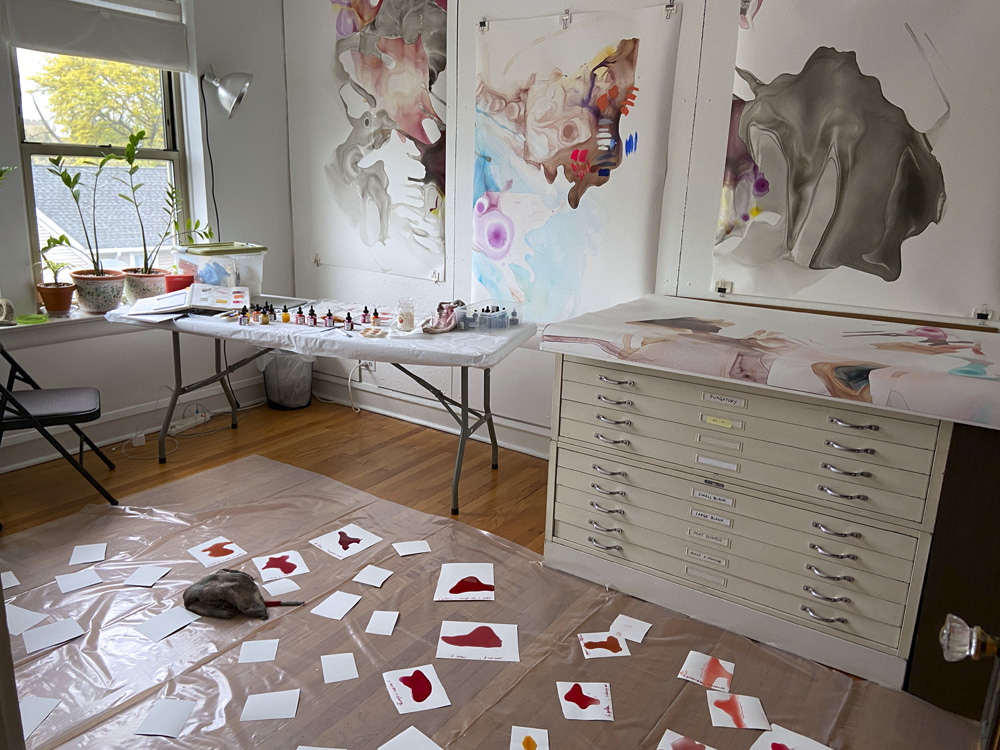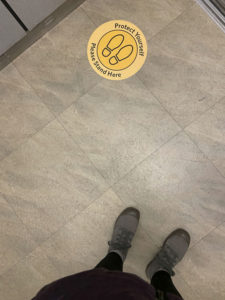
Approximately a decade ago, a friend of mine and I spent four years reading Phenomenology of Perception by Maurice Merleau-Ponty. We met weekly at a coffee shop and carefully went over each sentence until we finished the book in late 2017. To celebrate the feat, we threw a party titled “Motor Intentions Unfolding.” Any excuse for a party, right?
It wasn’t until last summer, in 2021, that the ideas from the book suddenly appeared in my artwork. I began thinking about what it would look like to visually represent the human body from a “first person singular” perspective, from a completely subjective standpoint. In truth, the concept is a paradox. Unlike looking at oneself in a mirror, or looking down at one’s own body (still a third-person view of oneself) I wanted to find out if there was a way to represent the body looking out, i.e. looking from a body.
For some reason, the most convincing things that resonated with my idea were objects that call to the body: a bathtub, a doorknob, a cup. I thought of Rachel Whiteread’s casts of building interiors as a way of referencing something that is not present but still haunts the viewer, or Curtain Wall, a phenomenal sculpture by Kara Hamilton, which creates a heightened awareness of looking. But these were three-dimensional examples. I wanted something that could function as a two-dimensional representation of “looking from.” This was important to me for a number of reasons; images of human bodies are so ubiquitous that we often take them for granted, and there are already so many conventional two-dimensional representations of the body that another point of view is much needed.

I realized that it was not only Merleau-Ponty but the pandemic as well that influenced my interest in this visual challenge. There were so many new visual markers that called to the body, e.g. the two footsteps in the elevator with “Stand Here” written around them, or things that vaguely represent a life-size human head with a mask at head height, or arrows showing direction of movement at the supermarket. The urban environment has always had visual markers that control the movement and concentration of populations, but these new pandemic guides stood out to me not only because they were new; many of them were also a lot more explicit and restrictive than the usual signs.


Based on these initial observations and thoughts, I created two pieces that started out the way I usually work, by recognizing forms in poured ink. The first one featured an image of a surgical mask placed at head height, and the other an image of a bubble wand next to what looked like a gap or hole in the ink. I asked a close friend to give me a cold read of the first piece. In a manner typical of him, he said that it looked like “a clown who died of geometric diarrhea.” Although this was meant as an inside joke (based on previous conversations about music critics and their often-futile attempts to describe the aesthetics of sound), it was nonetheless one of the most helpful critiques I’d received in a long time. It made me realize that my new work had something to do with carnival and the grotesque! This revelation led me into a rabbit hole where I discovered the astonishing writings of Rabelais and Bakhtin. So, I pushed all of the aforementioned ideas to the periphery and began following this new thread.
François Rabelais was, according to the literary theorist Mikhail Bakhtin, a widely misunderstood French writer from the 1500s. Rabelais’s grotesque humor was not merely a form of gratuitous indulgence. Instead, his humorous references to bodily topics such as food, sex, defecation, and nonsensical violence (think: old Tom and Jerry cartoons) came directly from marketplace carnival traditions in medieval France where an emphasis on bodily functions—in contrast to the mind or soul—restored a sense of grounded belonging and embodied kinship among the masses. The collective experience at these carnivals was further reinforced by subversion and erasure of hierarchies, labels, and propriety. Other traditions throughout history have had similar carnivalesque features—Saturnalia, Mardi Gras, Rio’s Carnival, and 1990s Candy Kid Raves come to mind.
I had read about some of these traditions several years ago when I made a bunch of ceramic hats for a Saturnalia-themed group exhibition. My practice had already internalized some of these concepts. But taking the last couple of years into consideration—as the world became increasingly isolated, alienated, and divided—I have felt a desire to approach the carnival aesthetic through two-dimensional work using masks, humor, exuberant color, and the grotesque. At this point (last summer) I had only made two pieces and my work was already headed in a completely new direction.

I prefer staying focused while deliberating and uncovering an idea, but this work was leaping ahead instead of developing. I was chasing after it. Each piece felt like a series onto itself. I decided to stop and take a break for some clarity and distance, so I abandoned drawing and painting, and made only traditional pottery for a year. After several months and hundreds of simple terracotta flower pots, I discovered that even they exhibited a carnival aesthetic! This was completely unplanned on my part. I couldn’t get away from it.
I applied to several residency programs for summer of 2022, hoping to return to drawing and painting with time to concentrate and untangle the new work away from distractions at home. I got accepted into three month-long residency programs, in June, July, and August, and none of them overlapped. It was overwhelming, to say the least, but I couldn’t say no to any of them.
My first residency was in upstate New York. I took a train there, settled into my new studio away from home, and began my journey into this new body of work.
Your comment on the carnival aesthetic, and the subversion and erasure of hierarchies, labels, and propriety brought to mind Bohemians (in my family tree) and Adamites!